First photographs released of Triumph’s TE-1 electric Speed Triple
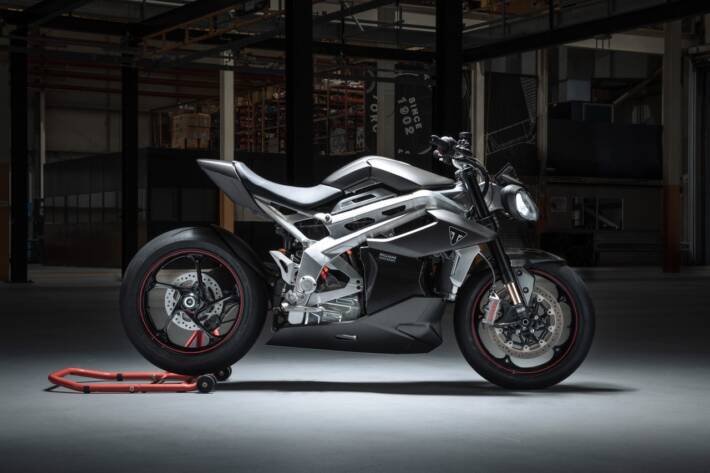
Last March, Triumph showed us the first details of its electric bike project, the TE-1. Back then, all we got to go on were some design sketches, a photo of an electric powerplant, and some interesting quotes from Triumph’s partners: Williams Advanced Engineering and Integral Powertrains, plus the University of Warwick, all of whom were working on the project. Now though, we’ve got some proper photos of a proper, rolling motorbike – which is pretty exciting.
Triumph TE-1
The pictures show off a couple of things which we didn’t know before. There’s a Gates carbon fibre toothed belt and square-toothed sprockets for the final drive, rather than a conventional chain. That might be there to smooth out the transmission, cut noise, or to deal with the particular torque characteristics of the electric powertrain. There’s also a fairly large radiator behind the front wheel, which might seem strange at first. If there’s no engine full of burning petrol, red-hot exhaust valves, boiling oil and high-pressure coolant, why do we have a radiator?
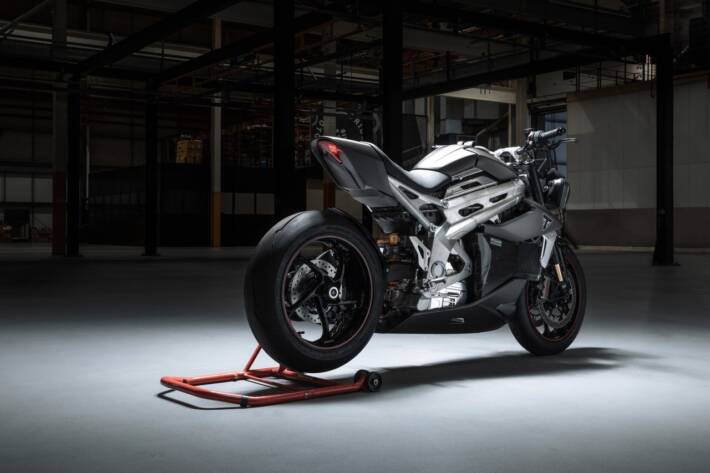 Triumph TE-1 electric Speed Triple
Triumph TE-1 electric Speed Triple
Well, compact, high-speed, high-powered electric motors do often use liquid cooling these days, rather than just air. And many high-performance automotive battery packs also use liquid cooling to manage thermal loads between individual cells – preventing overheating when charging, and discharging large transient current loads. Either or both of these systems will need a conventional liquid-air heat exchanger, or radiator.
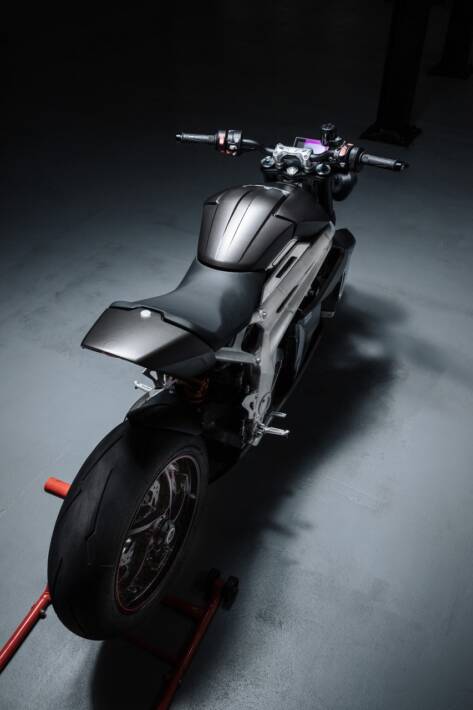 Triumph TE-1
Triumph TE-1
The Integral powerplant, with its combined motor and invertor unit is neatly packaged down in front of the swingarm, with the Williams Advanced Engineering battery pack located above and in front, where the engine would be on a normal bike. There’s also a charging port under the ‘fuel tank’ area.
The chassis components wouldn’t look out of place on any other current high-end Triumph roadster. There’s a tough-looking twin-spar aluminium frame with functional styling, and a single-sided rear swingarm as seen on the Speed Triple. The suspension is by Öhlins – adjustable USD front forks and a bespoke rear monoshock, presumably designed to cope with the extra weight of the battery pack. Brembo M50 calipers, Pirelli Super Corsas and a stubby seat unit rounds off the chassis setup nicely, and the angular twin headlamps are signature Triumph style.
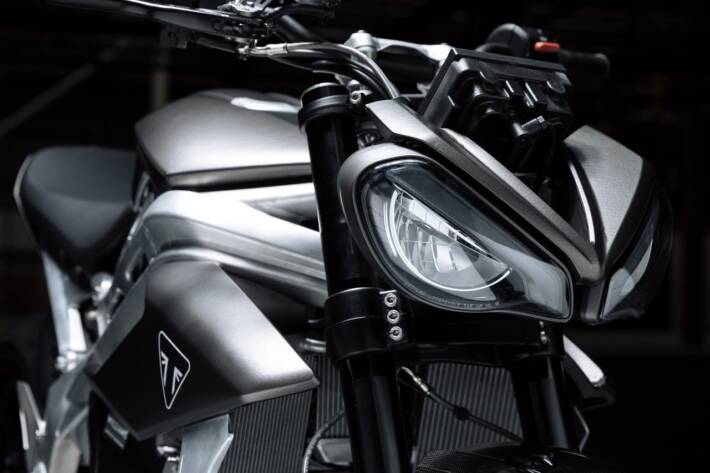 Triumph TE-1
Triumph TE-1
The Hinckley firm says the project has now finished what it calls ‘Phase Three’, which seems to have been the stage of engineering where the team simply checks that everything fits together, functions as it’s intended to do, and matches up with the simulations generated before the prototype was built.
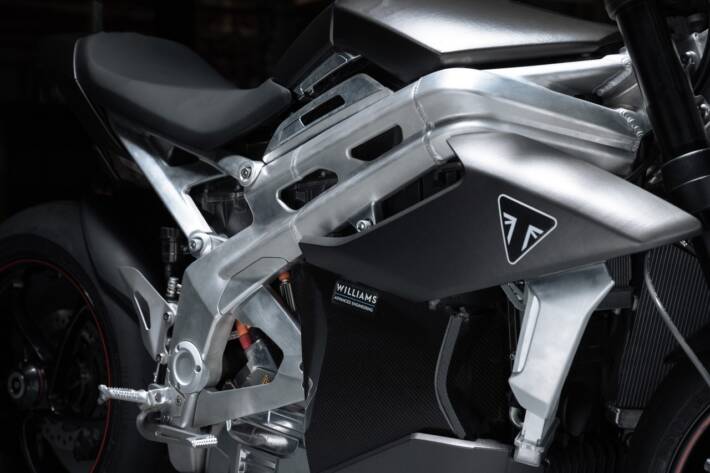 Triumph TE-1
Triumph TE-1
And now, the TE-1 is ready for, of course, Phase Four – which is the really exciting part. Starting out with rolling road tests, then onto the test track, Triumph engineers and test riders are going to be putting in the miles needed to get the baseline performance of the all-new machine up and running. Areas of development listed in the release include:
Rolling road testing – core functional assessment to include:
Throttle calibration
Powertrain performance mapping
Power and torque output
Range and battery consumption assessment
Rider mode development
Software functionality validation
Thermal optimisation
Track testing – encompassing dynamic rider assessment to include:
Handling
Acceleration
Braking and braking regeneration strategy
Traction control
Front wheel lift control
Amazingly, the firm reckons it will have all of this nailed by the end of summer 2022, which sounds like some fast work to us (though we are not motorcycle development engineers of course.)
Perhaps surprisingly, there’s no new spec listing for the bike, despite the firm giving some figures back in March 2021. The first release spoke of a 177bhp power output and a 220kg mass, with range of 120 miles and 0-80 per cent charging time of just 20 minutes. Whether the running prototype has radically altered the projected figures, or if Triumph is just keeping its powder dry, remains to be seen…
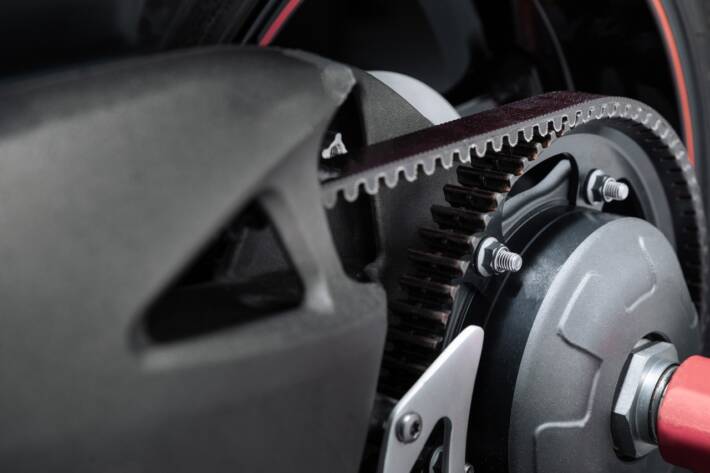 Triumph TE-1
Triumph TE-1
Expect more from Triumph on the TE-1 in time for the bike shows this autumn. And we’ll bring it all to you as soon as we get it!






